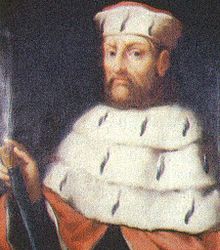Otto II Wittelsbach, Duke of Bavaria
| Otto II Wittelsbach, Duke of Bavaria | |
|---|---|

Portrait from Die Chronik Bayerns
|
|
| Spouse(s) | Agnes of the Palatinate |
| Noble family | House of Wittelsbach |
| Father | Louis I Wittelsbach, Duke of Bavaria |
| Mother | Ludmilla of Bohemia |
| Born |
7 April 1206 Kelheim |
| Died | 29 November 1253 (aged 47) Landshut |
| Buried | crypt of Scheyern Abbey |
Otto II of Bavaria (German: Otto II der Erlauchte, Herzog von Bayern, Pfalzgraf bei Rhein, 7 April 1206 in Kelheim – 29 November 1253) known as Otto the Illustrious was the Duke of Bavaria and Count Palatine of the Rhine (see Electorate of the Palatinate). He was a son of Louis I and Ludmilla of Bohemia and a member of the Wittelsbach dynasty.
Otto was born at Kelheim. At the age of sixteen, he was married to Agnes of the Palatinate, a granddaughter of Duke Henry the Lion and Conrad of Hohenstaufen. With this marriage, the Wittelsbach inherited Palatinate and kept it as a Wittelsbach possession until 1918. Since that time also the lion has become a heraldic symbol in the coat of arms for Bavaria and the Palatinate.
He was knighted in 1228 and given the Palatine County of the Rhine by his father, with his seat of power in Heidelberg. With the murder of his father in 1231 Otto also became Duke of Bavaria. There were rumors that the murderer had been bribed by the Hohenstaufen so Otto had a distanced relationship with Emperor Frederick II. His first years of government fulfilled disputes and feuds with the bishops of the country.
During his conflict with Frederick II, Duke of Austria Otto occupied Wels in 1233. This caused the hostility of King Henry who was in rebellion against his father Holy Roman Emperor Frederick II and allied with Frederick of Austria. Otto had to extradite his son Louis as a hostage. But the incident improved his relationship to the emperor who fearing the discontent of the German princes ordered to release Louis. But only in 1241 after a dispute with emperor Frederick II was finally ended, Otto joined the Hohenstaufen party. The previously unsteady Otto then remained true to the Emperor. Reasons were also the threat of the Mongol invasion of Europe and increaseing frictions with Wenceslaus I of Bohemia after the death of Frederick of Austria and suspiciousness against Henry Raspe. Otto's daughter, Elizabeth, was married to Frederick's son Conrad IV in 1246. Because of this, Otto was excommunicated by the pope. He was convinced by Bertold of Regensburg to repent in 1250. But when Otto died in Landshut in 1253 only 12 years later, at the request of the widow and the sons, his body was given an ecclesiastical burial. Pope Clemens declared that the Duke had given unmistakable signs of repentance. Like his forefathers, Otto was buried in the crypt of Scheyern Abbey.
...
Wikipedia
